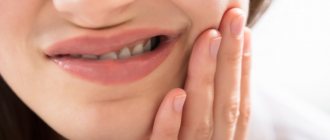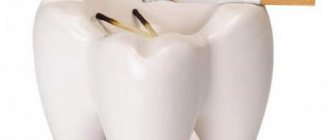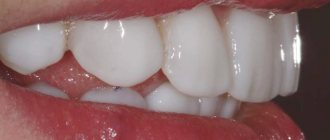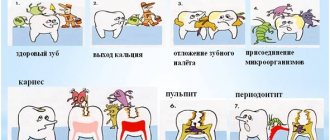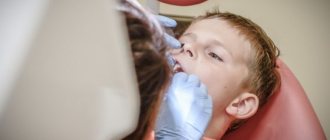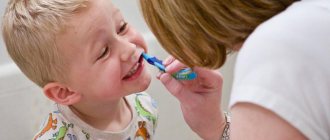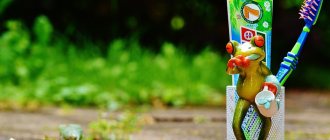Prevention of dental caries in children
During their short existence, baby teeth have a long-term impact and serve for proper biting and chewing, for the formation of vowels, and also preserve space for permanent teeth.
Children from 0-4 years
Teeth and gums hurt as a result of the action of certain bacteria. In the warm and moist oral cavity, they wait for the appearance of sugar or other sugar-containing products, and quickly begin to multiply, create a sticky mass - plaque - and secrete acid and cellular toxins, which harm the teeth and gums.
It is enough to follow simple rules:
- feed your child foods low in sugar;
- offer sweets that are friendly to teeth, i.e. sweet in taste and safe for teeth;
- care for children's teeth and gums from birth.
The condition of the teeth should be assessed by a specialist
Parents most often bring their child to the pediatric dentist only when there are already problems with the baby teeth. We practically don’t see healthy children whose parents want to make sure that the child’s teeth are always healthy and never hurt! For some reason, the opinion has now taken root that one cannot live without caries in life. So parents of children who already suffer from toothache and tooth decay come to us. Not all pediatricians talk about this, but parents should know that it is necessary to show the baby to the doctor at 6 months or when the first tooth emerges.
It is important to come to a specialist when there seems to be no cause for concern, because the initial stages of caries may be invisible to a layman. Caries begins when mineral substances are removed from the enamel under the influence of bacteria. As a result, a white spot forms on the surface of the tooth. It may be located in places that are inconvenient for inspection and masked by plaque, so parents may not see it or not attach any importance to it - after all, the tooth remains white.
The alarm begins to sound only when the tooth turns brown or black, a “hole” appears or the enamel chips. In this condition, the tooth requires serious and expensive treatment, which frustrates and disappoints parents.
Therefore, even if the teeth look healthy, you should visit the pediatric dentist every 2-3 months. The dentist’s experience and modern equipment make it possible to identify caries at the earliest stages and stop its development. To do this, for most children it is enough to remove plaque and treat the enamel with special means that will strengthen its structure and reduce the activity of microorganisms.
When all the baby teeth are there
How strong are they? Already in the 6th week of pregnancy, baby teeth begin to form. All of their 20 crowns are already fully developed by the time the child is born and take their permanent place in the jaws, even those that appear by the end of the first year of life.
Between 6 and 8 months of life, the first teeth appear. Alternately, they cut through the swollen gums. Sometimes this is a painful process, and the child worries and cries more often. In some cases, teething toys help, but how to deal with mom's loving concern? After all, in fact, there is no such disease as “teething.” Research shows that rising temperatures and other ailments during this period of life are a coincidence.
By the time all 20 baby teeth have erupted—which takes about 2 years—each one needs care.
Vitamins for teeth and gums
The baby should take vitamins to strengthen teeth and gums regularly, without missing a single day. This is the only way the child will receive a sufficient amount of nutrients. The daily complex must include:
- Retinol (vitamin A). An element necessary for bone growth. It is vitamin A that promotes protein synthesis in cartilage and bones, and also increases the cartilage layer in the growth zone. If a child's body does not have enough retinol, the process of bone tissue growth slows down, and new teeth may grow crooked. In addition, with vitamin A deficiency, the development of stomatitis and gum inflammation is often observed. In advanced cases, teeth may begin to fall out.
- Calciferol (vitamin D) is one of the key components of bone development. It is thanks to this vitamin that a child’s bones develop normally and mineral metabolism is regulated. Calciferol, as the name implies, helps absorb calcium and strengthens bone tissue. In summer and spring, a child can get vitamin D from sunlight by simply walking outside often. But in winter and autumn it is important to give children vitamin complexes with calciferol. With a deficiency of this element, mineral metabolism can be disrupted, bone tissue softens, rickets appears, and, of course, tooth enamel becomes thinner.
- Vitamin C is essential for strengthening gums. If there is a lack of ascorbic acid, the child may experience tissue bleeding, in advanced cases, ulcers appear in the mouth, an unpleasant odor disturbs, and teeth begin to loosen and fall out.
- Vitamins B6 (pyridoxine) and B12 (cyanocobalamin) are also needed to strengthen gums. It is B12 that provides tissue strength and prevents various inflammations, and the lack of cyanocobalamin makes the gums very sensitive.
- Vitamin E is involved in wound healing and helps fight pustules that so often appear on the gums of babies.
- Vitamin K (phylloquinone) strengthens connective tissue and protects gums from bleeding.
- Vitamin PP (nicotinic acid) is an important protector of gums from gingivitis, stomatitis and other inflammations.
Dental prevention. ATTENTION: SUGAR!
Sugar is found in breast milk and therefore cannot be excluded from the diet of infants. It is also present in healthy fruit juices and is the main cause of tooth decay. And in order to prevent it from appearing on children’s wonderful teeth, you, dear parents, must help them from the first day.
For children in the first year of life, special baby brushes are made of very soft bristles or completely made of rubber. Systematically, after each meal, the gums and baby teeth should be cleaned on all sides, for example, using a cosmetic spatula wrapped in dry cotton wool. Then you can start using the first soft toothbrushes as early as possible. You need to practice everything that brushes your teeth with fun and humor: open your mouth, show your teeth, brush them, rinse your mouth. Try to effectively use children's curiosity and desire to imitate adults - and brushing your teeth will become real fun associated with pleasant emotions.
At 2 years old, your child already has his own brush with a small, soft head and a small, thick handle. Cleaning is done “from red to white”, i.e. sweeping movements from the gums to the teeth, chewing, internal and external surfaces of the teeth. Proper and good cleaning is not such a simple matter. Be sure to monitor the child and repeat the procedure if necessary.
How to teach a child to brush their teeth
For children aged 3–8 years, motivation when brushing their teeth is very important. Dentists recommend using different tips for this: for example, a timer or a calendar.
But before we look at specific products, let’s first talk about the principles that will help a child with proper brushing and develop a responsible attitude towards dental health.
- Follow a cleaning routine. It is best to teach your child to brush his teeth at the same time in the morning and evening.
- Children learn by example. This works better than any persuasion. At the very beginning, take your child with you to the bath and give him a brush - let him try to simply repeat after you. Over time, the game will become a habit, and he will remind you to brush your teeth.
- Give your child a choice. Let him choose his own toothpaste and brush, or better yet, a few to suit his mood. Variety every day will not let him get bored.
- Don't force, but motivate. Get your baby interested through games, a timer or a special calendar. With proper motivation, the child will not even notice how he will begin to follow all your recommendations with pleasure.
As for specific means of motivation, we will highlight three main ones.
- Timer. Agree with your child in advance that brushing your teeth will take exactly as long as the sand is poured in (doctors recommend at least 2 minutes). As a result, the baby will stop rushing and start watching the grains of sand. The timer can be either in the shape of an hourglass or built into an electric brush.
- Teeth brushing calendar. Hang it in the bathroom in a visible place so that the child can easily reach it. The teeth cleaning calendar can be of any type and design. For example, it may consist of 30 or 31 windows depicting the sun and moon. Each time, after brushing his teeth, the child will paint over or cover with a sticker the sun (in the morning) and the moon (in the evening).
- Means for detecting dental plaque . They allow you to quickly and easily monitor the effectiveness of teeth brushing in children, motivating them to take careful care. The products turn plaque blue, after which it can be easily removed with a toothbrush.
And don't forget to celebrate your baby's successes. Praise always motivates you to new achievements. For example, give your child figurines or stickers that he likes at the end of the week. The main thing is to agree with him about this in advance.
All the most necessary hygiene products for children from 3 to 8 years old are collected in our children's set No. 2. It includes:
- Children's toothbrush Curaprox Smart 7600;
- Biorepair toothpaste (Kids for 0–6 years or Junior for 7–14 years);
- Preventive foam Splat Junior with calcium and lactic enzymes;
- Anti-caries lozenge with xylitol Miradent Xylipop;
- Plaque indicating rinse Miradent Plaque Agent;
- Hourglass to control brushing time;
- Teeth cleaning calendar.
These are basic products that will help your child maintain healthy oral microflora and fight tooth decay.
Prevention of dental caries
Children 4-6 years old
Baby teeth are often underestimated, but they play a very important role in the future development of a child.
First, the child uses his baby teeth to bite and chew. When they are positioned correctly, food is properly ground and prepared for digestion.
Secondly, baby teeth make it possible for a child to speak correctly. A lisp, for example, is a consequence of too early loss of baby teeth.
Third, baby teeth hold space in the jaw for permanent teeth. The child's molars should remain until they are 11-12 years old.
Baby teeth cannot resist caries. Therefore, you need to remember that after eating and drinking, especially sticky sweets, food remains remain between the teeth, get stuck in the recesses of the molars, along the edges of the gums. The oral cavity is home to millions of bacteria that convert sugars and carbohydrates into harsh acids, which in turn attack and dissolve tooth enamel. To protect yourself from caries, you need to remember:
Should baby teeth be preserved?
“Do I need to keep baby teeth if they fall out in a couple of years? Do they really need prevention?! But permanent teeth are a different matter!” - this is what many parents think and say. “But if a child has chronic diseases, no one will wait to treat them in adulthood; everyone understands that their trace will go into adulthood,” notes Victoria Korchagina. “The same thing happens with teeth: if baby teeth are damaged, destroyed, they were treated a lot and often removed, it means that the permanent ones will face the same fate.”
There is a direct connection between general immunity and the condition of the oral cavity. Caries develops more actively in children who have chronic diseases. And vice versa, the higher the activity of caries in a child, the more often he stays at home and does not go to kindergarten due to illness, the more prone he is to intestinal problems, allergic reactions, and respiratory diseases.
Typically, the pathogenic and non-pathogenic flora of the oral cavity are in a state of balance, but as soon as a person gets sick, this balance is disrupted, increasing the risk of diseases of the teeth, gums and mucous membranes.
A vicious circle arises. A sick, weakened child refuses to brush his teeth, and his parents sympathize with him - so as not to be capricious again, they stop brushing his teeth. As a result, after another illness, the child develops new carious cavities and gums bleed.
Multiple caries, in turn, supports foci of chronic infection in the body. Therefore, you should always brush your teeth: both in sickness and in health. This will help not only to recover faster, but also not to get sick as often.
Prevention of dental treatment - brush correctly
about rinsing your mouth or chewing sugar-free gum after every meal and sweets.
Children 6-12 years old
When new teeth are on the way
Something happens in your mouth, or more precisely in the upper and lower jaws: one baby tooth after another says goodbye to you, and new permanent teeth appear in their place. This process will last up to 12 years! Exception: at the age of 6, the permanent one is visible behind the last milk tooth, although none falls out. This is a six-year-old molar. It is important for the further development of the dentition. Therefore, it needs special care and must be coated with a special sealing compound. The reason: the enamel of the “new” teeth is not yet completely hard at the time of eruption and is therefore at risk of caries. The same applies to the remaining molars.
From the appearance of the first tooth until the first grade, an adult should brush the child’s teeth.
Dentists around the world today are unanimous: a child’s teeth should be brushed from the moment the first tooth appears with a brush and toothpaste containing fluoride. These can be special brushes for the little ones, as well as finger brushes, which are made of silicone and are put on an adult’s finger. “Such brushes gently massage the gums, making teething easier,” explains Victoria Korchagina. “You can also purchase special wipes online to care for the baby’s oral mucosa and clean teeth between meals.”
A parent or other adult should brush a child's teeth until school age. Until the age of 6–7 years, a child cannot do this himself carefully and efficiently, no matter how smart he is. Why?
- Only by the first grade does the child’s brain structures responsible for fine motor skills mature (therefore, he is already able to master writing, which is akin to methodically brushing his teeth).
- Young children have no idea of the value of their own health. Only parents have it, and most of them have it not in relation to themselves, but in relation to the child. Therefore, only the parent is truly important about the child’s daily hygiene. The child does not need it and is not interested.
Brushing teeth becomes interesting for a child when an adult comes up with important motivation and shows consistency and perseverance. If adults are inventive and methodical in their desire to raise a child healthy, then by the age of 7 daily hygiene becomes a habit for the child: he automatically repeats the learned actions, imitating the parent.
For responsible adults, dentists recommend that they monitor their teeth brushing until they begin adolescence (10–12 years of age). But if a habit has been formed since early childhood, maintaining it at school age will no longer require much effort.
The article was written by our head. doctor V.V. Korchagina for the portal RastimDetei.rf
Stored hermetically
Your teeth can cause you a lot of problems, because they have so many vulnerable places: the cavities of the chewing surfaces of the molars, the interdental spaces, the necks of the teeth and the edges of the gums. This is where the sticky coating forms. The bacteria in it greet everything sweet with great joy. Then they multiply millions of times. Their waste products - acids - cause caries.
Filling the chewing surfaces of teeth with special compounds (sealing) means their protection and safety and is performed by a dentist. Despite this, all teeth should be thoroughly brushed and floss should be used between teeth. Ask your dentist to tell you more about sealants and flossing.
Almost half of children have an incorrect bite. Make sure that your child does not encounter such a problem. A significant role in the prevention of dental caries is played by the prevention and elimination of developed dentoalveolar deformities. Orthodontic treatment aimed at normalizing the bite, eliminating crowding of teeth, and reducing the likelihood of caries.
13-18 years old
Communication between people is becoming easier: for on-line surfing on the Internet, just a mouse click is enough... Only one thing complicates the communication process. Each serving of fast food with ketchup, ice cream, cola and other similar daily snacks throws our most important communicative organ - the mouth - out of ecological balance. When there is not enough systematic oral care, caries naturally occurs and gums hurt.
How to choose a clinic for treating children
Dental treatment for children in Moscow is offered by a number of family and children's dentistry, so the quality of services in the capital is quite high due to competition. The same can be said about many other large cities, where specialized dentistry is also opening. The choice of clinic and doctor is important not only from a clinical point of view, but also from the point of view of the child’s psychological health. The best children's clinic is the one that doesn't look like a hospital, so it's the atmosphere that comes to the fore. Thematic design, a decorated children's area, a playful form of treatment, the presence of not only specialized dentists on staff, but also psychologists - options, the presence of which indicates that the clinic has a proven concept and does not just offer a list of services. Be that as it may, before taking your child to an appointment, you need to collect as much information as possible from available sources (clinic website, independent sources on the Internet, patient reviews), and, if possible, personally communicate with the doctor or administrator.
Prevention of dental diseases
Two phases characterize caries :
Phase I – “demineralization” of teeth. Dissolution of enamel crystals under the tooth surface. Outwardly, everything looks OK, only white, chalk-like spots signal danger. At the first stage, everything is curable, but with the condition of intensive dental care. If sugar continues to be present, your teeth will have a particularly hard time.
Phase II - the appearance of a hole in the tooth - caries. But this is already incurable!
Fluorine is nature itself
Fluoride is not only found in our saliva, it is a natural component of our environment and a mineral that can be called an absolute “power” for teeth and bones. Fluoride increases the resistance of enamel to acids.
How much does dental treatment for children cost in Moscow?
The cost of treating children's teeth consists of several components. First, the clinical case itself is assessed. In particular, with serious tooth decay and carious lesions, deeper and more complex treatment is necessary. Much depends on the treatment technology, the materials used, as well as on the level of the clinic itself (the higher its status, the higher the prices). Below is a table in which we have indicated the cost of various services for the treatment of primary and molar teeth.
| Service | Price in Moscow |
| Treatment of simple caries of a baby tooth | From 2,000 rubles |
| Treatment of complex caries of baby teeth | From 3,000 rubles |
| Treatment of molar caries | From 3,000 rubles |
| Treatment of pulpitis | 4,000 - 7,000 rubles depending on the complexity and number of dental canals |
| Treatment of caries without a drill using Icon technology | 5,000 - 7,000 rubles |
| Fissure sealing | 700 - 1,000 rubles per 1 tooth |
| Fluoridation of baby teeth | 3,000 - 4,000 rubles for all baby teeth |
| Air Flow teeth cleaning | 3,000 rubles |
| Removing a baby tooth | 1,500 - 3,000 rubles depending on complexity |
| Molar tooth extraction | From 2,000 rubles |
| Local anesthesia | 500 rubles |
| Sedation | 2,000 - 5,000 rubles depending on the degree of depth and duration |
| General anesthesia | 12,000 - 16,000 rubles |
Prevention of children's teeth - care
Our body’s “laboratory” produces fluoride in saliva, but it is no longer enough to effectively protect our teeth. Too many Big Macs, Snickers, and chewy candies have made it difficult for saliva to perform this function. She needs help:
- brush your teeth twice a day with a toothpaste containing fluoride;
- once a week, carry out intensive fluoridation with products containing fluoride (gels, for example);
- coat your teeth with fluoride varnish monthly;
- eat fluoridated salt.
If plaque is not regularly removed from teeth, it turns into tartar, visible on the surface of the teeth. Tartar increases in size and imperceptibly “grows” under the gums towards the root of the tooth. A thin layer of tartar is stained by exposure to nicotine, tea or red wine.
Fluoride varnish coating is professional protection against caries. Professional cleaning means removing tartar, incl. deposits invisible to the eye, which should be carried out by the dentist at least twice a year.
But that is not all. Only polishing finally rids the roots of residual layers of tartar.
Moreover. Polishing makes it more difficult for stone to form. Polishing all surfaces of the teeth after removing plaque using brushes, polishing heads, superflosses, strips, brushes and pastes allows you to make your teeth very smooth. Only with the help of professional cleaning can gum disease be cured. And the degree of its success can be checked with the tip of your tongue!
Note to moms
Although baby teeth begin to erupt at 6 months, and by 2.5 years all twenty teeth are already present, their formation begins already during pregnancy. Therefore, the expectant mother needs to eat food rich in calcium and fluoride, which are the main building materials for teeth. The same is necessary for the child, since after birth the body begins to build permanent teeth, which, after changing the milk ones, should serve him for the rest of his life.
I must say honestly, ideally constructed tooth enamel is the strongest material in the body, which is not afraid of any microbes, the problem is that in most people the enamel is not built perfectly with microdefects, where microbes rush.
How does this happen? After eating, plaque forms on the surface of the teeth, oral microbes interacting with this plaque form an acid, which dissolves the tooth enamel, the first line of defense, forming a carious cavity, after which, rushing inside the tooth, it can reach the living part of the tooth (pulp) and even cause her death.
The later the cavity is detected, the more difficult the treatment will be and the more unpleasant experiences the child will have associated with it. Therefore, prevention is very important.
What problems can parents solve on their own?
From a very early age, minimize the child’s consumption of caramel candies, toffees, sweet suckers, and cakes. You especially have to keep an eye on what grandparents bring. If you want to please your child with something sweet, it would be better if it were fruit, honey, ice cream (dairy products contain calcium, which is good for teeth), or at least real natural chocolate. Under no circumstances should you give sweet drinks at night; at night, ideal conditions for bacteria that cause caries are formed in the child’s mouth; in addition, the child subsequently gets used to sweets faster.
And naturally, it is necessary to brush your child’s teeth twice a day, morning and evening, to prevent plaque formation. You should start brushing your teeth after the first teeth erupt. This can be done simply with a clean napkin or gauze; after two years, you can start using a toothbrush. At first, parents have to brush their teeth together with their child, but the sooner you start accustoming your child to this procedure, the faster he will learn to do it on his own.
And you definitely need to show your child to the dentist at least once every six months. A child's visit to the doctor is always stressful, so it is better if the acquaintance with the dentist begins simply with preventive examinations when the child turns one year old. Subsequently, by the age of three to four years, he will perceive the environment of the dental office more adequately and be more relaxed about treatment if it is needed.
Parents should know that baby teeth, just like permanent teeth, need to be treated and it is obvious that it is better to do this in the early stages of caries development. This avoids oral infection, pain, tooth decay and early removal. Early removal of primary teeth disrupts the normal development of the bite and subsequently leads to orthodontic problems, the correction of which will require large time and financial costs.
Before visiting the dentist, you don’t need to tell your child: “It won’t hurt,” “You’ll have to be patient for a little while,” “They’ll give you an injection,” “They’ll drill your teeth.” This only instills fear in the child. Dentists generally “don’t drill,” “don’t pull,” “don’t prick.”
Today, dental technologies have come a long way and make it possible to provide safe and reliable pain relief; there are new aesthetic and non-toxic materials for treatment and filling.


